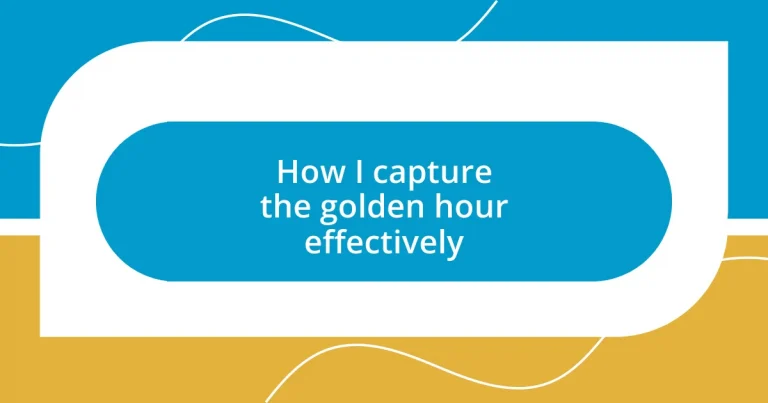Key takeaways:
- The golden hour enhances photography with soft, warm light, creating beautiful colors and shadows ideal for capturing emotions and scenery.
- Proper timing and preparation are crucial; using essential gear like tripods and wide-angle lenses can significantly improve the quality of golden hour shots.
- Post-processing techniques, such as adjusting white balance and utilizing selective edits, can elevate golden hour images and enhance storytelling.

Understanding the golden hour
The golden hour, often celebrated among photographers, refers to the period shortly after sunrise and before sunset when the sunlight takes on a soft, warm quality. I remember my first experience during this time; it felt like the world transformed into a magical tapestry of vibrant colors. Isn’t it fascinating how light can completely change the way we perceive our surroundings?
During this hour, shadows become elongated, and the harshness of midday sun fades away, creating a more flattering light for portraits and landscapes alike. I often wonder how many incredible moments are missed simply because we rush through our days, oblivious to the beauty just waiting to be captured. Have you ever stopped to notice how the light dances differently at this time?
Understanding the science behind this phenomenon is equally compelling. The angle of the sun contributes to the golden hues we see, as it passes through more atmosphere, scattering shorter wavelengths of light. This creates that ethereal glow that makes everything bathe in warmth, drawing out deeper emotions in both subjects and viewers. I’ve found that soaking in this light can spark creativity and inspiration in ways that nothing else does.
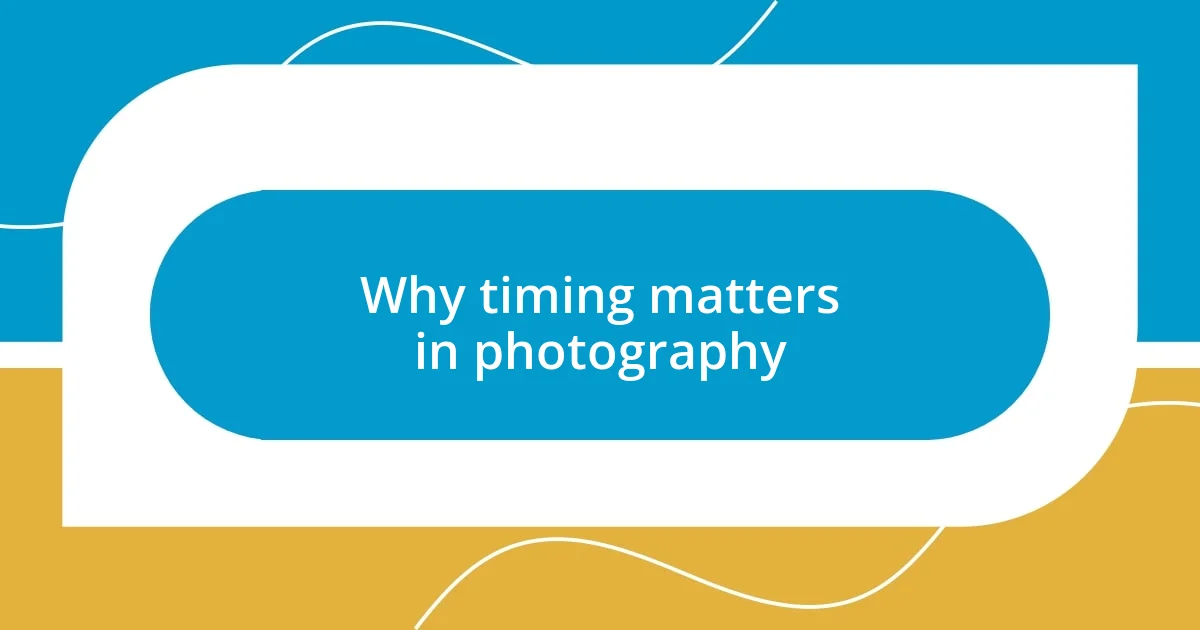
Why timing matters in photography
Timing in photography can be a game-changer; it’s about more than just when we click the shutter. I’ve often found myself scrambling to capture a scene just as the sun dips below the horizon. Those moments remind me how fleeting light can be — it’s here and gone in an instant. Have you ever felt that rush? The pressure to seize a perfect shot when everything is just right can spark both excitement and frustration.
When I think about how timing influences the mood of an image, I can’t help but recall a golden hour shoot I had by the lakeside. The water mirrored the sky’s vibrant hues, creating an almost surreal effect. Timing allowed me to freeze that stunning interplay of light and reflection — moments like these illustrate just how pivotal it is to be present and aware. Realizing the importance of precise timing has shaped my approach to photography immensely.
The contrast between different times of day is staggering. While midday sun can cast harsh shadows and create unflattering highlights, the tender light of the golden hour softens everything it touches. It’s in these quiet hours that nuances emerge, revealing layers in the scene that might otherwise go unnoticed. Sometimes, I’ve found that simply being patient and waiting for the sun to play its magic is the best technique I can employ.
| Time of Day | Lighting Characteristics |
|---|---|
| Golden Hour | Soft, warm tones; elongated shadows; enhanced colors |
| Midday | Harsh, direct light; strong shadows; washed-out colors |

Essential gear for golden hour
When gearing up for the golden hour, having the right equipment can make all the difference. I’ve learned that a solid tripod is essential; it keeps your camera steady while capturing those soft, flowing movements of light. There’s nothing quite like setting up my trusted gear and watching how the sunset shifts the colors around me. I remember a time when I didn’t have a tripod, and all I got were blurry images. It reinforced the importance of preparation in photography.
Here’s a quick list of essential gear that I recommend for capturing the golden hour effectively:
- Tripod: Maintains stability and allows for longer exposures.
- Wide-Angle Lens: Captures more of the stunning landscape and expansive skies.
- ND Filters (Neutral Density): Reduces light entering the lens, creating stunning long-exposure effects.
- Reflector: Bounces light onto your subject, enhancing those warm tones.
- Extra Batteries: Cold evenings can drain batteries quickly—better to be prepared!
Equipping myself with these tools has transformed my golden hour shoots into engaging, rewarding experiences. I can’t help but feel a sense of anticipation as I prepare my camera, knowing that magic awaits just beyond the horizon!
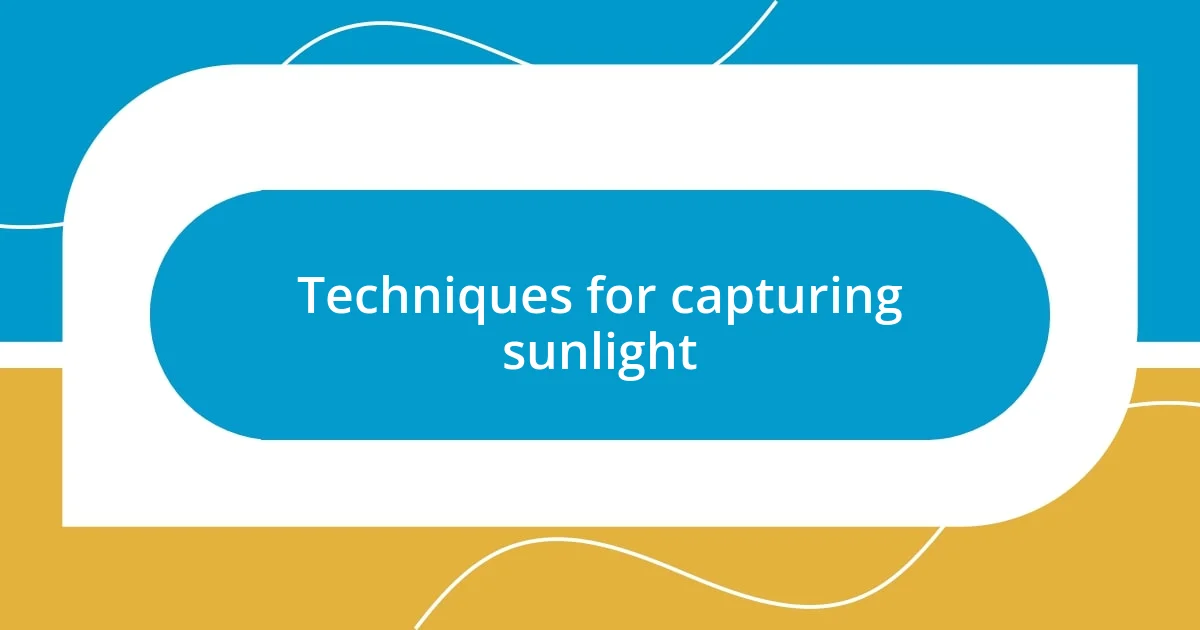
Techniques for capturing sunlight
Capturing sunlight during the golden hour can be an exhilarating experience that significantly enhances your photography. One technique I’ve found beneficial is using backlighting to create a magical halo effect around subjects. I remember shooting a silhouette of a friend with the sun behind them, and as the light enveloped them, it created this ethereal glow that was utterly captivating. Have you ever experienced a moment where light transformed your image into art? It’s those little adjustments in positioning that can yield such stunning results.
Another technique I love is playing with angles. Instead of shooting straight on, I often find that tilting my camera or adjusting my perspective reveals dynamic compositions. During one adventure in a sunflower field, shifting my angle allowed me to capture the sun peeking through the petals. This not only added depth to the image but also evoked feelings of warmth and joy. As I snapped that picture, it struck me how sometimes a simple change in approach can lead to wholly different and beautiful outcomes.
Lastly, experimenting with shadows is a technique that I enjoy when capturing sunlight. By positioning my subjects to cast interesting patterns, I’ve created striking contrasts that pull the viewer’s eye into the frame. I recall a time when I captured a friend’s form against the backdrop of a sun-drenched wall, and the interplay of shadow and light made for a powerful visual that evoked a sense of serenity. It begs the question: how can shadows deepen the narrative of your photos? Exploring this element can unleash creativity and breathe life into your scenes.
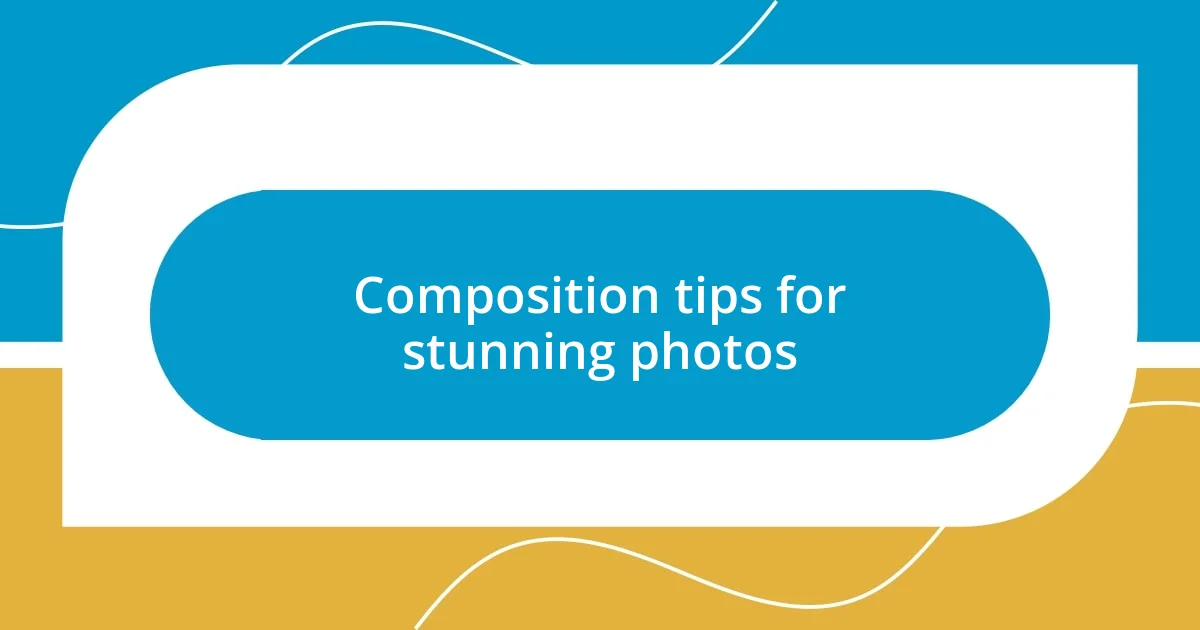
Composition tips for stunning photos
One of the best composition tips I’ve picked up is the rule of thirds. Simply put, this guideline divides your frame into nine equal parts using two horizontal and two vertical lines. I often find that placing my subject along these lines or at their intersections creates a more dynamic and visually pleasing image. I’ll never forget snapping a photo of a striking landscape where I positioned the horizon line along the top third—this little adjustment made the sky seem so much more expansive. Have you tried it? It really changes the way you see your composition.
Another tip that has changed my approach is leading lines. Roads, rivers, or pathways that draw the viewer’s eye into the frame can create a sense of depth and movement. I vividly remember capturing a serene lakeside scene where the path along the shore led right to the sunset. That visual journey not only directed attention but also evoked feelings of peace and exploration. How often do you think about how paths can guide your viewers through your photography?
Finally, don’t forget to embrace negative space. It might seem counterintuitive, but giving your subject some breathing room in the frame can help it stand out. During a recent shoot, I intentionally left a lot of open sky around a lone tree silhouetted by the setting sun. The simplicity of that space emphasized the subject’s isolation and beauty. Have you considered how minimalism could enhance your storytelling? Sometimes, less really is more in photography.
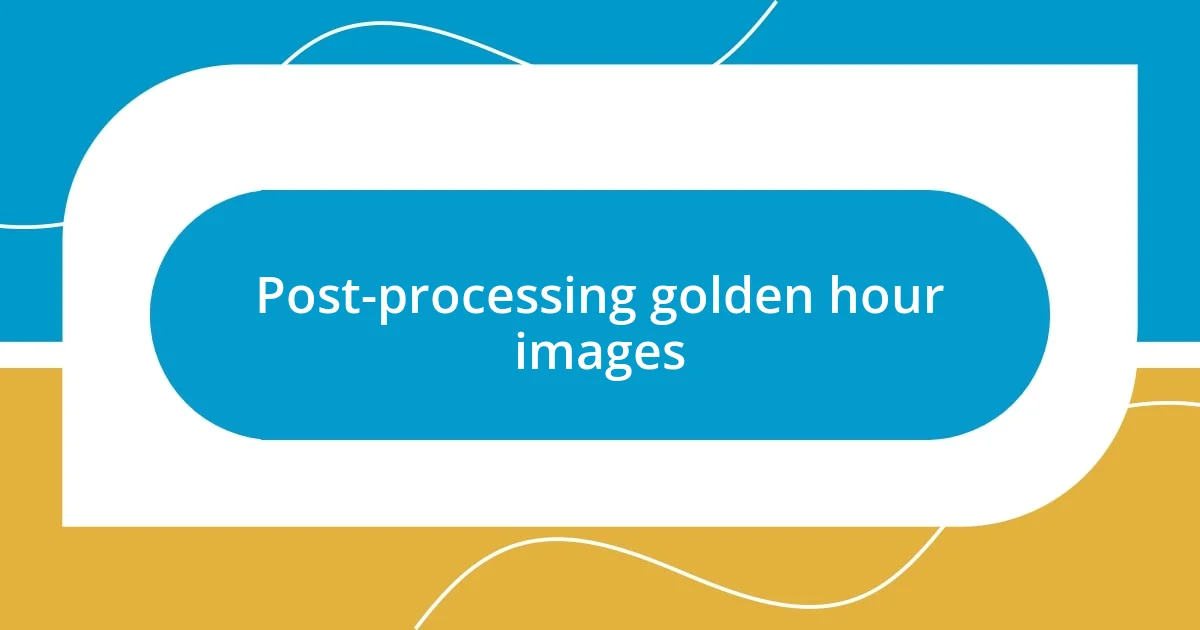
Post-processing golden hour images
When I sit down to process my golden hour images, the first thing I do is adjust the white balance. During that magical time, the light can create stunning warmth, but sometimes it can be a bit too yellow or orange. Recently, while editing an image of a sunset over the ocean, I found that slightly adjusting the white balance back made the colors pop even more vividly. It’s all about finding that sweet spot where the beauty of the moment is truly reflected.
I also love to play with saturation and contrast during post-processing. Increasing the saturation just a notch can enhance those vibrant colors without making them overly gaudy. I remember working on a photo of a sunflower field bathed in golden light. Boosting the contrast gave the flowers a delightful richness that made them practically leap off the screen. Have you considered how just a little tweak can transform your image from good to breathtaking?
Lastly, I’m a firm believer in utilizing selective editing tools. Instead of applying adjustments globally, I focus on specific areas that need attention. For instance, when I shot a cozy picnic during golden hour, I selectively brightened the highlights on the blanket while deepening the shadows around it. This not only drew the eye to the central moment but also created an inviting atmosphere that captured the essence of that perfect evening. How do you think selective edits could enhance your storytelling in photography? Exploring these tools can really add depth and personality to your work.
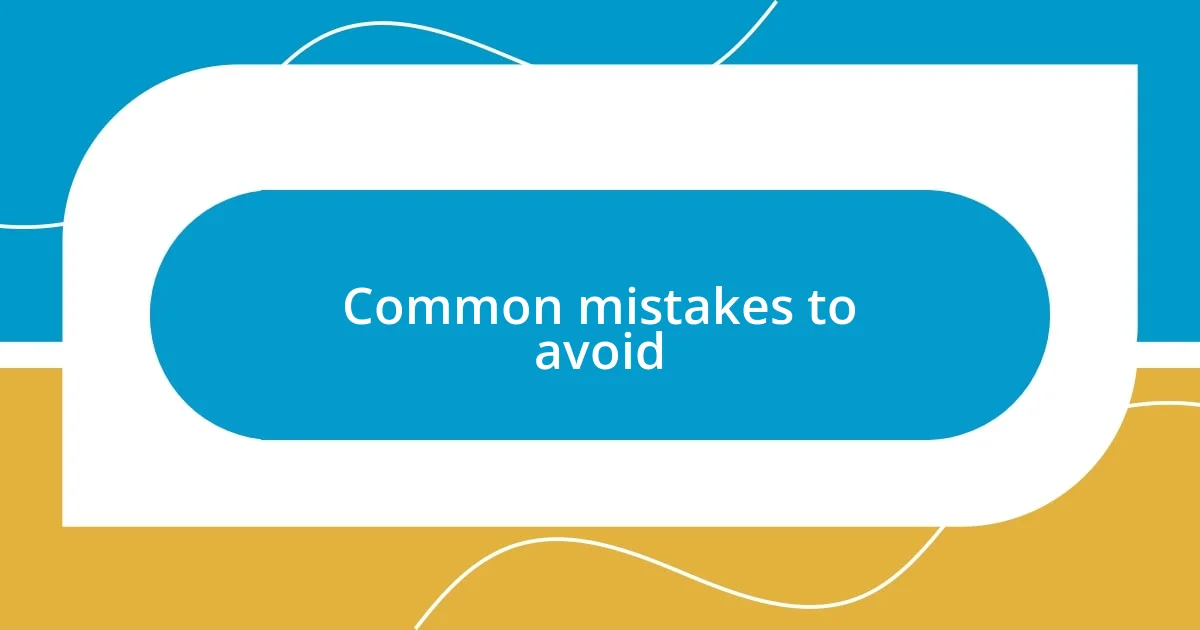
Common mistakes to avoid
One common mistake I’ve made—and seen others make—is not planning for the ever-changing light conditions. Golden hour is fleeting, and the light can shift dramatically in just a few minutes. I remember rushing to set up my shot only to realize the perfect golden hue had faded into a bland gray as clouds rolled in unexpectedly. How often do we underestimate the importance of knowing the weather and timing?
Another pitfall is being too attached to a specific composition instead of being flexible. While I understand the desire to stick to your vision, sometimes the best shots happen when you adapt to the scene in front of you. I recall a time when I stubbornly tried to frame a photo just as I had envisioned it, but the wind picked up, and the flowers I was capturing began to sway beautifully. Letting go and adjusting on the fly led to a stunning shot that I wouldn’t have achieved otherwise. Have you ever found yourself caught up in your original plan and missing out on spontaneous beauty?
Lastly, I often warn against neglecting your camera settings. In the excitement of golden hour, I’ve forgotten to adjust my ISO or aperture, resulting in overexposed or underexposed images. During one shoot, I was so mesmerized by the sunset that I didn’t check my settings, and I ended up with a shot that totally lost the magic of the moment. It’s a heart-sinking feeling, isn’t it? Always take a moment to ensure your gear is set up for success before diving into the beauty of golden hour.












